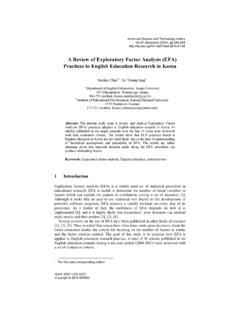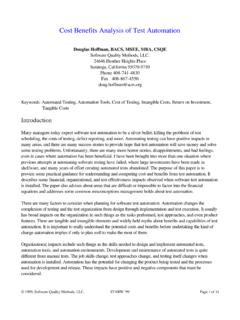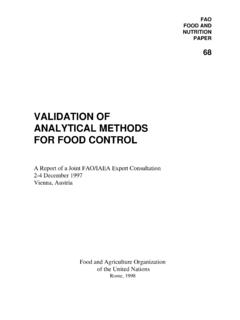Transcription of 211-30: Statistical Methods in Diagnostic Medicine …
1 1 Paper 211-30 Statistical Methods in Diagnostic Medicine using SAS Software Jay N. Mandrekar, , Sumithra J. Mandrekar, Division of Biostatistics, Mayo Clinic, Rochester, MN ABSTRACT An important goal in Diagnostic Medicine research is to estimate and compare the accuracies of Diagnostic tests , which serve two purposes 1) providing reliable information about a patient s condition and 2) influencing patient care. In developing screening tools, researchers often evaluate the discriminating power of the screening test by concentrating on the sensitivity and specificity of the test and the area under the ROC curve. We propose to give a gentle introduction to the Statistical Methods commonly used in Diagnostic Medicine covering some broad issues and scenarios. In particular, power calculations, estimation of the accuracy of a Diagnostic test, comparison of accuracies of competing Diagnostic tests , and regression analysis of Diagnostic accuracy data will be discussed.
2 Some existing SAS procedures and SAS macros for analyzing the data from Diagnostic studies will be summarized. These concepts will be illustrated using datasets from clinical disciplines like radiology, neurology and infectious diseases. INTRODUCTION The purpose of a Diagnostic test is to classify or predict the presence or absence of a condition or a disease. The clinical performance of a Diagnostic test is based on its ability to correctly classify subjects into relevant subgroups. Essentially, these tests help answer a simple question: if a person tests positive, what is the probability that the person really has the disease / condition, and if a person tests negative, what is the probability that the person is really disease / condition free? As new Diagnostic tests are introduced, it is important to evaluate the quality of the classification obtained from this new test in comparison to existing tests or the Gold Standard. In this review paper, we discuss the different Methods used to quantify the Diagnostic ability of a test (sensitivity, specificity, the likelihood ratio (LR), area under the receiver operating curve (ROC)), the probability that a test will give the correct diagnosis (positive predictive value and negative predictive value), and regression Methods to analyze Diagnostic accuracy data.
3 We will also discuss comparisons of areas under two or more correlated ROC curves and provide examples of power calculations for designing Diagnostic studies. These concepts will be illustrated using SAS macros and procedures. SIMPLE MEASURES OF Diagnostic ACCURACY The accuracy of any test is measured by comparing the results from a Diagnostic test (positive or negative) to the true disease or condition (presence or absence) of the patient (Table 1). Table 1: Cross Classification of Test results by Diagnosis Disease / Condition Test results Present Absent Positive True Positive (TP) False Positive (FP) Negative False Negative (FN) True Negative (TN) The two basic measures of quantifying the Diagnostic accuracy of a test are the sensitivity (SENS) and specificity (SPES) (Zhou et al., 2002). Sensitivity is defined as the ability of a test to detect the disease status or condition when it is truly present, , it is the probability of a positive test result given that the patient has the disease or condition of interest.
4 Specificity is the ability of a test to exclude the condition or disease in patients who do not have the condition or the disease , it is the probability of a negative test result given that the patient does not have the disease or condition of interest. In describing a Diagnostic test, both SENS and SPES are reported as they are inherently linked in that as the value of one increases, the value of the other decreases. SENS and SPES are also dependent on the patient characteristics and the disease spectrum. For example, advanced tumors are easier to detect than small benign lesions and detection of fetal maturity may be influenced by the gestational age of the patient (Hunink et al., 1990). In clinical practice, it is also important to know how good the test is at predicting the true positives, , the probability that the test will give the correct diagnosis. This is captured by the predictive values. The positive predictive value (PPV) is the probability that a patient has the disease or condition given that the test results are positive, and the negative predictive value (NPV) is the probability that a patient does not have the disease or condition given that the test results are indeed negative.
5 To illustrate these concepts, consider an example where results from a Diagnostic test like x-ray or computer tomographic (CT) scan and the true disease or condition of the patient is known (Altman and Bland, 1994a). The different measures discussed above along with the 95% exact binomial confidence intervals for each estimate can be calculated (see Table 2A). Statistics and Data AnalysisSUGI30 2 Table 2A: Example: Test results by Diagnosis (Prevalence = 75%) Disease Status / Condition Test results Present Absent Total Positive 231 (TP) 32 (FP) 263 Negative 27 (FN) 54 (TN) 81 Total 258 86 344 SENS = 231/258 = (95% CI: ) SPES = 54/86 = (95% CI: ) PPV = 231/263 = (95% CI: ) NPV = 54/81 = (95% CI: ) The 95% exact binomial confidence intervals can be calculated using the %bnmlci macro from the Mayo Clinic (see reference 1 under SAS macros resource) using the following call statement: %bnmlci(width=, x=, n=); where x= observed number of successes in n trials and width=width of the CI (default is 95).
6 For example, %bnmlci(x=231, n=258); RUN; would give the 95% CI for the SENS estimate in the above example. Prevalence is defined as the prior probability of the disease before the test is carried out. For example, the estimate of the prevalence of the disease considered in Table 2A is 75% (258/344). The PPV and the NPV are dependent on the prevalence of the disease in the patient population being studied (Altman and Bland, 1994b). To put this in perspective, suppose that the prevalence of the disease considered in Table 2A is actually 25% (Table 2B). The PPV and the NPV are 77/173 = and 162/171 = , but the SENS and the SPES remain unaltered. Table 2B: Example: Test results by Diagnosis (Prevalence = 25%) Disease Status / Condition Test results Present Absent Total Positive 77 (TP) 96 (FP) 173 Negative 9 (FN) 162 (TN) 171 Total 86 258 344 Both SENS and SPES can be applied to other populations that have different prevalence rates, unlike the predictive values, which are dependent on the prevalence of the disease or condition being tested.
7 It is therefore not appropriate to apply universally the PPV and the NPV obtained from one study without information on prevalence. For instance, the rarer the prevalence of the disease, the more sure one can be that a negative test result indeed means that there is no disease, and less sure that a positive test result indicates the presence of a disease. Also, the lower the prevalence, greater is the number of people who will be diagnosed as FP, even if the SENS and the SPES are high, as seen in example given by Table 2B. The Likelihood Ratio (LR) is yet another simple measure of Diagnostic accuracy, given by the ratio of the probability of the test result among patients who truly had the disease / condition to the probability of the same test among patients who do not have the disease/condition. In other words, the LR is really the ratio of SENS / (1-SPES). The LR for the example considered above is Clearly it is also a measure that is independent of prevalence of the disease / condition.
8 The magnitude of the LR informs about the certainty of a positive diagnosis. As a general guideline, a value of LR=1 indicates that the test result is equally likely in patients with and without the disease/condition, values of LR > 1 indicate that the test result is more likely in patients with the disease / condition and values of LR < 1 indicate that the test result is more likely in patients without the disease / condition (Zhou et al., 2002). The LR can also be defined in terms of the pre-test and post-test probabilities of the disease / condition. In the example given by Table 2A, the pre-test probability of the disease / condition (or the pre-test odds of disease) = / ( ) = (since the prevalence of the disease is ). The post-test probability of the disease / condition is given by (231/263) / (1-(231/263)) = ( ) = = x = pre-test odds of disease x LR. Thus, the LR can also be interpreted as the ratio of the post-test probability of disease/condition to the pre-test probability of the disease/condition.
9 AREA UNDER THE ROC CURVE Both SENS and SPES require a cutpoint in order to classify the test results as positive or negative. The SENS and SPES for a Diagnostic test are therefore tied to the Diagnostic threshold or cutpoint selected for the test. Many times the results from a Statistics and Data AnalysisSUGI30 3 Diagnostic test may be on an ordinal or numerical scale rather than just a binary outcome of positive or negative. In such situations, the SENS and SPES are based on just one cutpoint when in reality multiple cutpoints or thresholds are possible. An ROC curve overcomes this limitation by including all the decision thresholds possible for the results from a Diagnostic test. An ROC curve is a plot of the SENS versus (1-SPES) of a Diagnostic test, where the different points on the curve correspond to different cutpoints used to determine if the test results are positive. As an illustration, consider ratings of CT images from 109 subjects by a radiologist, given by Table 3 (Hanley and McNeil, 1982).
10 Clearly, in this example, multiple cutpoints are possible for classifying a patient as normal or abnormal based on the CT scan. The designation of a cutpoint to classify the test results as positive or negative is relatively arbitrary. Suppose that the ratings of 4 or above indicate, for instance, that the test is positive, then the SENS and SPES would be and In contrast, if the ratings of 3 or above are considered as positive, then the SENS and SPES are and respectively. This illustrates that both SENS and SPES are specific to the selected decision threshold. Table 3: True Disease Status by CT Ratings CT Ratings True Disease Status 1: Definitely Normal 2: Probably Normal 3: Unsure 4: Probably Abnormal 5: Definitely Normal Total Normal 33 6 6 11 2 58 Abnormal 3 2 2 11 33 51 Total 36 8 8 22 35 109 A better way to represent this data is an ROC curve (Figure 1), which does not require the selection of a particular cutpoint.

















